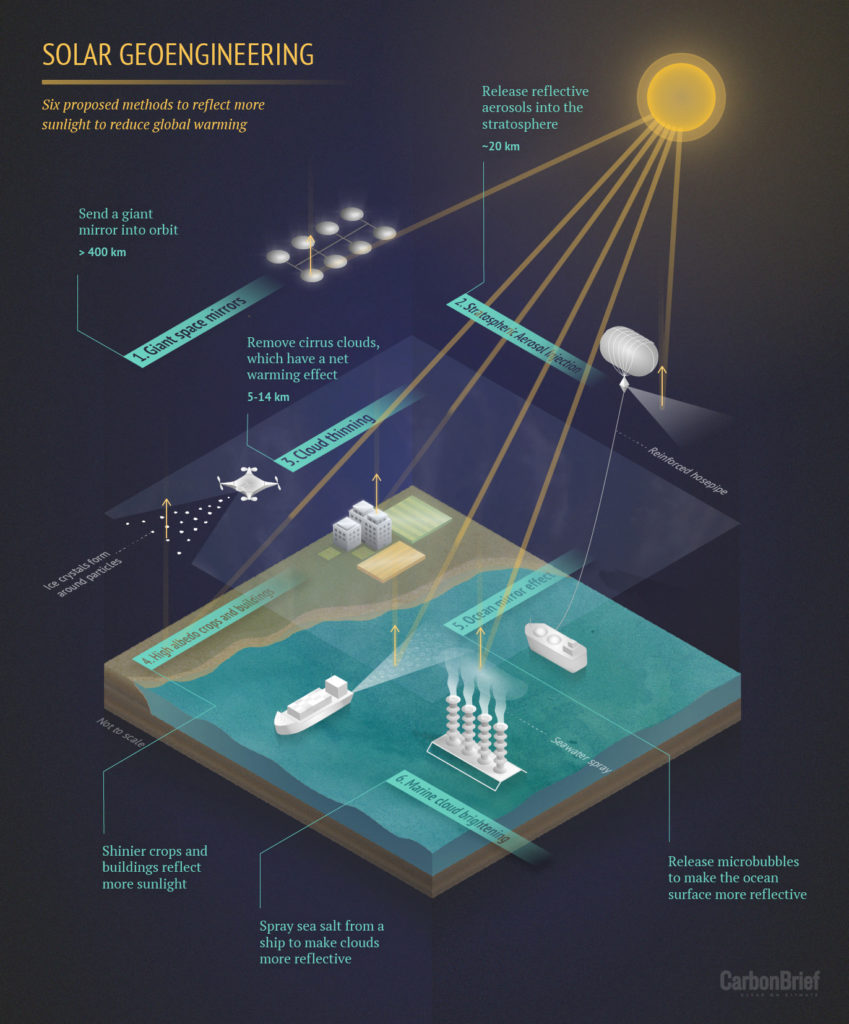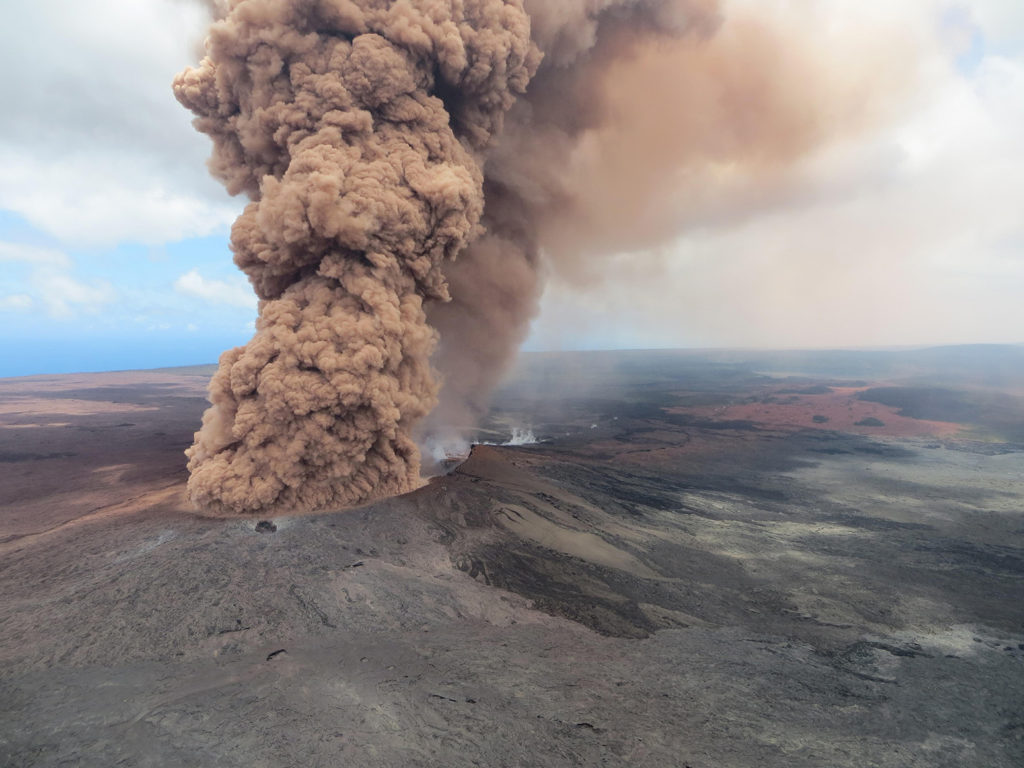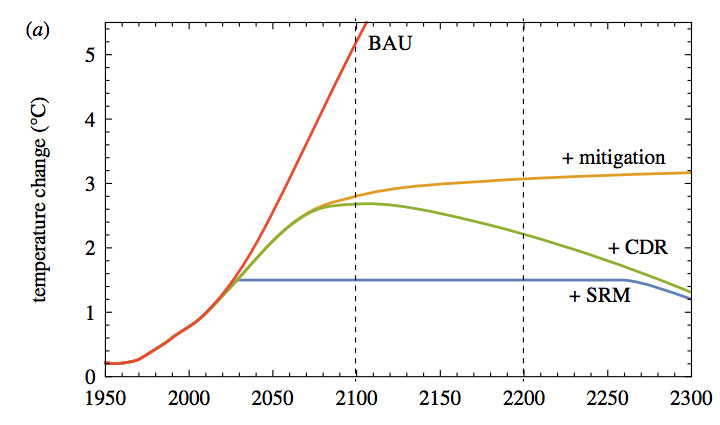
Explainer: Six ideas to limit global warming with solar geoengineering
Daisy Dunne
05.09.18Daisy Dunne
09.05.2018 | 3:11pmScientists agree that cutting global greenhouse emissions as soon as possible will be key to tackling global warming. But, with global emissions still on the rise, some researchers are now calling for more research into measures that could be taken alongside emissions cuts, including – controversially – the use of “solar geoengineering” technologies.
Solar geoengineering is a term used to describe a group of hypothetical technologies that could, in theory, counteract temperature rise by reflecting more sunlight away from the Earth’s surface.
From sending a giant mirror into space to spraying aerosols in the stratosphere, the range of proposed techniques all come with unique technical, ethical and political challenges.
Carbon Brief spoke to the scientists who are pioneering research into these techniques to find out more about their potential uses, shortfalls and overall feasibility.
Heating up
All types of solar geoengineering – known also as solar radiation management (SRM) – are united by their goal of limiting the effect of sunlight on the Earth, but they vary widely in their approach.
Possible methods include reducing heat-trapping clouds, sending a giant sunshade up into orbit or releasing aerosols into the stratosphere.
It is worth noting that, although these technologies could theoretically lower global warming, they do not aim to reduce the amount of greenhouse gases in the atmosphere and, therefore, would not be able to directly address problems such as ocean acidification.
However, research shows that using solar geoengineering could indirectly lower the amount of CO2 in the atmosphere by stemming permafrost melt, reducing energy-sector emissions and causing changes to the carbon-cycle feedback.
The idea of engineering the climate in order to limit sunlight has been debated by scientists and politicians for more than 50 years, but – apart from studies based on computer simulations – very little field research has been carried out.
However, in recent months, interest in SRM appears to be growing. In October of last year, scientists met in Berlin to discuss the future of geoengineering. Last November, the US House of Representatives held a subcommittee meeting on geoengineering, with SRM dominating the conversation.
But this interest has been met with resistance by some scientists and campaigners, who say that the potential risks of such technologies are still far from fully understood.
Some fear that a geoengineered world could come with its own set of environmental and societal challenges, which they say could be comparable to – or even worse than – climate change.
Below, Carbon Brief outlines the possible uses, shortcomings, costs and feasibility of the six most commonly proposed solar geoengineering technologies.

Solar Geoengingeering options. Graphic by Rosamund Pearce for Carbon Brief.
Aerosol injection
Spraying aerosols high up into the stratosphere is currently the most talked-about form of SRM. The technique, which is known as “stratospheric aerosol injection”, could cool the planet in a similar way to a large volcanic eruption.
When a volcano erupts, it sends an ash cloud high into the atmosphere. The sulphur dioxide released in the plume combines with water to form sulfuric acid aerosols, which are able to reflect incoming sunlight.

Volcanic plume rises from the Kilauea volcano following a 6.9-magnitude earthquake 4 May 2018 in Leilani Estates, Hawaii. Credit: Planetpix / Alamy Stock Photo.
Researchers have proposed that artificially introducing aerosols into the atmosphere – via a plane or a high-altitude balloon – could have a similar cooling effect. The amount of cooling could be large, says Dr Anthony Jones, an atmospheric scientist at the University of Exeter. He tells Carbon Brief:
“We know after the Mount Pinatubo eruption in 1991 there was a global cooling of about half a degrees for two or three years afterwards, so it does seem that injecting aerosols into the stratosphere is quite effective.”
Research suggests that releasing aerosols could also help to bring back global rainfall patterns to their pre-industrial averages.
However, this is dependent on how aerosols are used, Jones says. For example, his research finds that releasing aerosols in just the northern hemisphere could lead to a decrease in rainfall – and, therefore, an enhanced drought risk – in India and the African Sahel. And there’s a mix of other potential regional impacts, he explains:
“We found that the solar geoengineering could either reduce the frequency and intensity of storms in the North Atlantic basin or, if you did radical solar geoengineering in just one hemisphere, then you’d actually increase the number of storms.
“[Researchers] have looked at changes to climate extremes, such as heatwaves, extreme precipitation events, cold nights. They’ve found that solar geoengineering over land regions could be very effective at reducing these extremes.”
Some scientists have raised concerns that, if aerosols were used to address global warming, the world could be left at risk of a “termination shock”. That is, if aerosols were released and then suddenly stopped – as a result of political disagreement or a terrorist attack, for example – global temperatures could rapidly rebound.
This sharp temperature change could be “catastrophic” for wildlife, studies have suggested. However, other research argues that the likelihood of a termination shock has been “overplayed” and that measures could be put in place to ensure that the risk is minimised.
Aerosol injection could have an edge on other proposed forms of solar geoengineering because it would not require a large technological leap to become a reality, Jones says:
“We have aircraft that can go to that altitude already, high up into the upper troposphere and lower stratosphere.”
However, existing aircraft may not be large enough to carry the equipment needed to perform the aerosol release, says Prof Alan Robock, a professor in the department of environmental sciences at Rutgers University. At the sidelines of this year’s European Geosciences Union General Assembly, where Robock took part in a panel debate on geoengineering, he told Carbon Brief:
“Even if you could, what do you spray? Do you spray sulphur dioxide gas? When the sulphur comes down, it’s going to create acid rain.”
Sulphur dioxide is often proposed as the most likely candidate for aerosol release. However, others have suggested that sulfuric acid or hydrogen sulfide could also be used.
Despite recent research, it is still “very difficult” to gauge what the true impacts of using aerosols to cool the planet would be, says Dr Ben Kravitz, an atmospheric scientist from the Pacific Northwest National Laboratory.
This is because the technique “only exists in the modelling world”, he told Carbon Brief at the sidelines of a conference held in Berlin last October. In the video below, he explains why there is still “so much we don’t know”:
With this issue in mind, a team of researchers from Harvard University plan to carry out later this year one of the first field experiments looking into the possible impacts of releasing aerosols.
The timeline below offers more detail on how this experiment, known as SCoPEx, would work. It also includes the details of two previous attempts to bring solar geoengineering research out into the open.
Marine cloud brightening
The second most talked-about option for solar geoengineering is “marine cloud brightening”. In theory, this could involve using ships to spray saltwater into the clouds above the sea.
Once airborne, the salt particles would act as “cloud condensation nuclei”, meaning they would facilitate the condensation of water vapour into liquid. As more water droplets are created, clouds would appear larger and brighter.
These brighter clouds would reflect away more sunlight, says Prof Douglas MacMartin, an engineering researcher from Cornell University, who contributed to the US House of Representatives’ hearing on geoengineering. He tells Carbon Brief:
“It would simply be making those existing clouds just a little bit brighter and could help cool planet.”
Unlike aerosol injection, marine cloud brightening could, in theory, be used over very specific areas, he says:
“It may be possible, for instance, to just cool over coral reefs. Or it may be possible to only cool in one particular region off the Gulf of Mexico that would reduce hurricane strength in that area. But I think a lot of that is still just an idea.”
Research into these ideas has so far been scant, he says. A few studies based on modelling suggest that marine cloud brightening may be able to “restore temperatures and ice cover”, address coral bleaching, and could have a “mixed” impact on global crop yields.
However, concerns remain over how using marine cloud brightening could affect other aspects of the climate system, MacMartin says:
“In contrast to something like SAI [stratospheric aerosol injection] – where you have a very spatially small effect over the entire planet – you have a large and very localised effect and that could lead to much more regional variation in the climate response.”
This variation could possibly lead to unfavourable weather in some parts of the world, says Dr Anthony Jones:
“You may be getting global cooling of 1-2C on average, but that’s entirely confined to certain regions and that would really upset weather patterns, ocean circulation and local biology.”
High-albedo crops and buildings
Another proposed technique that is starting to turn heads is the idea of increasing the albedo of buildings in order to reflect more sunlight. Put simply, this would involve making rooftops and walls brighter – by painting them white, for example.
Although this technique is much less controversial, it is also unlikely to make a large difference to global temperatures, says Prof Sonia Seneviratne, a geophysicist from ETH Zurich, who recently published a literature review on the topic. However, it could be used in cities to counteract heatwaves, she tells Carbon Brief:
“In cities, it could potentially help reduce the highest temperatures to reduce health problems for the population during heatwaves. White buildings are already common in some areas, for instance, in the Mediterranean.”
Scientists have also suggested that the same technique could be applied to crops, possibly by introducing genes that would give plants a waxy sheen. To date, research into this idea has remained theoretical. Seneviratne says:
“If more reflective crop species can be developed…this could decrease local and regional temperatures, in particular, during heatwaves. However, these potential benefits should be carefully weighed against potential negative side effects, for instance, on crop productivity and, thus, food production.”
The technique could be used on a smaller scale than other proposed technologies, such as stratospheric aerosol injection. This means the risk of issues, such as “cross-boundary conflict” and termination shock, could be much smaller, she says:
“Land radiative management is not aiming to reduce the global temperature and so allows some regional limitation of the effects.”
Ocean mirror
A less well-known option for limiting the effects of sunlight would be to use an “ocean mirror”. In theory, this would involve using a fleet of sea vessels to churn up millions of tiny microbubbles on the ocean surface.
This seafoam would reflect away sunlight, cooling the planet, explains Prof Julian Evans, an emeritus professor in materials science from University College London. He tells Carbon Brief:
“The reflectance of ocean foam can be more than ten times higher than the ocean itself and the ocean occupies 71% of our planet’s surface so enhancing sea foam is a sensible and simple way to reflect a few per cent more sunlight.
“Obviously, the main criterion for a climate intervention is that it must be capable of being shut down fast if things start to go wrong. An ocean foam is shut down when the bubbles burst.”
While the possible cooling effect of microbubbles could be large, there could be drawbacks to the technique.
In a 2010 research paper, Evans suggested that using microbubbles could reduce the amount of sunlight reaching below the ocean’s surface, which may negatively impact marine ecosystems.
With less light penetrating the ocean surface, marine plants – otherwise known as primary producers – may be less able to carry out photosynthesis. This could lead to a drop in the number of marine plants, which could have knock-on effects further up the food chain.
However, more recent research modelling the impacts of using microbubbles to address global warming found that the technique would not affect ocean primary productivity, a measure of the activity of primary producers.
On top of this, creating enough microbubbles at the ocean’s surface to have an overall cooling effect on the planet could require large amounts of energy, according to research co-authored by Evans. The research paper notes that the main energy cost would come from sustaining the bubbles for several days or weeks after they are first created.
Cloud thinning
Another less-explored option for reducing the effects of sunlight at the Earth’s surface would be to “remove” cirrus clouds from the atmosphere.
Cirrus clouds are thin, wispy clouds made of ice crystals, which form at high altitudes. The clouds reflect away some sunlight, but also absorb large amounts of long-wave radiation – meaning that, on balance, they warm the planet.
The overall heat-trapping effect of cirrus clouds is so large that it exceeds that of human-released CO2, says Prof Ulrike Lohmann, an atmospheric scientist from ETH Zurich who recently published a review on cloud thinning in Science. She tells Carbon Brief:
“Therefore, if we could remove all cirrus clouds, we could more than offset the warming caused by a doubling of CO2 [in the atmosphere].”
In theory, aerial vehicles such as drones could be used to deliver and then inject solid aerosol particles, such as desert dust or pollen, into cirrus clouds. Seeding the clouds in this way would cause them to dissipate more quickly, lessening their overall warming effect.
However, overseeding could lead to the formation of thicker and more persistent cirrus clouds, Lohmann says in her research paper:
“If cirrus cloud thinning is not done carefully, the effect could be additional warming rather than the intended cooling.”
On top of this, large questions remain over how cirrus cloud thinning could affect other aspects of the climate system, such as atmospheric circulation, the paper concludes:
“Only after these questions are addressed could one move further to explore the costs and feasibility of cirrus cloud thinning.”
Space sunshades
The final SRM technology discussed by scientists involves sending a giant mirror – or fleet of mirrors – into orbit in order to reflect away more sunlight from the Earth.
The size of the mirror would determine how much sunlight it could reflect back towards space and, therefore, its cooling effect, says Prof Govindasamy Bala, from the Divecha Centre for Climate Change at the Indian Institute of Science. He tells Carbon Brief:
“Approximately a 2% reduction in incoming sunlight [using a sunshade] is sufficient to offset the warming from a doubling of CO2 from the pre-industrial level of 280ppm to 560ppm. The current CO2 level is about 400ppm.”
But introducing a space mirror into orbit – either around the Earth or the sun – would be a huge technological challenge, Bala says. And, once introduced, it would need to be continually altered to deal with further rises in atmospheric CO2, he says:
“On the positive side, sunshades are implemented in space and, hence, environmentally they are the least disruptive. However, as a negative, it requires the most advanced technology for implementation and, hence, the costs are probably prohibitively expensive when we compare with other solar geoengineering techniques.”
Substitute or supplement?
One issue looming over solar geoengineering research is how – if at all – it will be used by society. There is currently no clarity among policymakers over whether any technology, or combination of technologies, should one day be used to address global warming.
A larger question mark hangs over how solar geoengineering could sit alongside mitigation efforts.
Some scientists and campaign groups believe that solar geoengineering could be viewed by politicians as a quick “technofix” to climate change. If more research and development is channeled into these techniques, they argue, politicians may start to backpedal on their promises to cut their greenhouse gas emissions.
This issue should be considered “the major barrier” to the implementation of solar geoengineering, says Bala:
“People might think there is a solution to climate change and, hence, abandon the efforts in CO2 emission reduction. This might allow CO2 to build to dangerous levels in the atmosphere by the end of this century.”
However, other scientists say that solar geoengineering should be considered as a “supplement” rather than a quick fix. Speaking at the Climate Engineering Conference held in Berlin last year, Keith said:
“In my view, solar geoengineering is – at best – a supplement to emissions cuts, not a substitute for them. It is possible that a combination of emissions cuts, carbon removal and solar geoengineering could provide a significantly safer climate than emissions cuts alone or emissions cuts and carbon removal combined. Possible, but unproven.”
Reaching 1.5C
Earlier this month, MacMartin, Keith and Prof Katharine Ricke, a climate scientist from the University of California, San Diego, published a research paper exploring how solar geoengineering – via releasing aerosols into the stratosphere – could be used as part of an “overall strategy” for limiting global warming to 1.5C, which is the aspirational target of the Paris Agreement.
The researchers used a set of climate models to simulate changes in temperature and other variables over the next three centuries under a range of future scenarios.
The scenarios include: “business as usual” (BAU), which assumes no mitigation efforts are made (“RCP8.5”); “mitigation”, which assumes an intermediate level of emissions (“RCP4.5”) without negative emissions; “carbon dioxide removal” (“CDR”), which assumes moderate emissions with long-term CO2 removal; and “solar radiation management” (“SRM”), which is the same as the CDR pathway, but also includes enough SRM to limit temperatures to 1.5C above pre-industrial levels by 2100.
The results are shown on the chart below, where colour shows the results for BAU (red), mitigation (orange), CDR (green) and SRM (blue). Dashed lines mark the start of a new century.

Projected global average temperature rise above pre-industrial levels under a range of future scenarios, “business as usual” (BAU), which assumes no mitigation efforts are made (RCP8.5); “mitigation”, which assumes moderate emissions (RCP4.5) without negative emissions, “carbon dioxide removal” (CDR), which assumes moderate emissions with long-term CO2 removal; and “solar radiation management” (SRM), which is the same as the CDR pathway but also includes enough SRM to limit temperatures to 1.5C by 2100. Source: MacMartin et al. (2018)
The results show that, at around 2100, the mitigation scenario and CDR scenario result in global warming of around 2.7C, while the SRM scenario is used to hold warming at 1.5C.
The SRM scenario assumes that the world would start releasing aerosols in 2030 and continue until past 2250. It expects aerosol release to reach a peak at around the year 2100, when close to 5m tonnes of sulphur dioxide would be released into the atmosphere.
However, the researchers point out that using solar geoengineering to hold global warming to 1.5C would not have the same environmental effect as reaching the target using mitigation. This is largely because using SRM would not significantly reduce the amount of CO2 in the atmosphere. The research paper reads:
“Since geoengineering would not affect the climate the same way [as mitigation], a lower global mean temperature anomaly achieved using geoengineering does not necessarily lead to lower aggregate climate risks. Choosing an appropriate level that balances different risks to the climate system will not be straightforward.”
Also, in a similar way to negative emissions technologies, solar geoengineering would not see the additional benefits for health of reducing fossil fuel emissions and improving air quality.
Controlling the global thermostat
Another unresolved aspect of geoengineering research is the issue of governance. Though ideas are beginning to emerge, it is still not clear who could be responsible for carrying out and regulating solar geoengineering.
At present, research into solar geoengineering is largely restricted to the US, the UK and other parts of Europe – although China recently launched the world’s largest geoengineering research programme.
But earlier this month, a group of scientists and policymakers from the global south published a letter in Nature calling for developing nations to take the lead on SRM research.
Developing countries are likely to be the most affected by future climate change, research shows.Therefore, “it is right” for these nations to play “a central role in solar geoengineering research, discussion and evaluation”, the group argues.
A small number of initiatives aim to widen participation in SRM research. The Solar Radiation Management Governance Initiative (SRMGI) recently released funding for research projects that plan to model the impacts of SRM in developing nations.
In addition, the Carnegie Climate Geoengineering Governance Initiative (C2G2) has been established to “encourage a broader, society-wide discussion about the risks, potential benefits, ethical and governance challenges raised by climate geoengineering”.
Speaking to Carbon Brief last year, C2G2’s executive director Janos Pasztor said developing a system of global governance for solar geoengineering research and regulation will “require more global cooperation than has ever been attempted before”.
The challenge could be so large that it could stop the development of solar geoengineering altogether, says Dr Anthony Jones:
“I actually find it very difficult to imagine a scenario where all countries agree on a certain amount of global warming that they want to counteract. How much solar geoengineering do you do – and where? I really struggle to picture that scenario.”
Agreeing on a global geoengineering strategy would require even more cooperation than efforts to cut global emissions, says Prof Alan Robock:
“You’re asking if the world can come together and agree on geoengineering without agreeing on mitigation. I think the answer is for us to agree on mitigation. Paris is the first step, the pledges made there aren’t enough but have got to increase.”
One way researchers could start to tackle the global governance issue is by dividing it into smaller parts, says Dr Joshua Horton, research director of geoengineering at Keith’s research team at Harvard University. He tells Carbon Brief:
“There will be a number of governance challenges – related to moral hazards, decision making, democracy, compensation, termination risk – a whole slew of things that aren’t easy to solve. It helps to start by recognising there’s a complex of problems that need to be addressed.”
Including more political scientists and governance experts in conversations about geoengineering will be vital to solving the problem, he adds:
“If there are solutions, they’re the ones who are going to actually figure out how we can proceed and, if we can’t, they’ll be the ones to make that determination as well.”
Solar Geoengineering infographic by Rosamund Pearce
-
Explainer: Six ideas to limit global warming with solar geoengineering
-
Explainer: Could solar geoengineering help to limit global warming?





